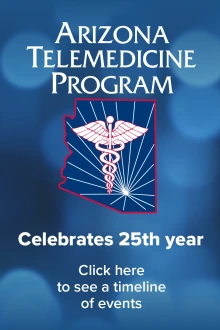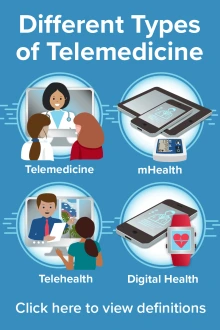Pandemic a Watershed Moment for Telemedicine
The Arizona Telemedicine Program celebrates its 25th year as telehealth is growing in demand around the country spurred by increased use tied to COVID-19.

During the pandemic, telemedicine allowed people to safely meet with their health care providers while maintaining physical distance.
If ever there was a moment for telemedicine to shine, the COVID-19 pandemic was it. And shine it has, said Ronald S. Weinstein, MD, a University of Arizona College of Medicine – Tucson pathology professor and founding director of the Arizona Telemedicine Program (ATP), which celebrates its 25th anniversary this year.
“All the elements for telemedicine were actually in the pipeline but moving slowly over a very long period of time,” said Dr. Weinstein. “Then the pandemic and social distancing hit, and waivers were granted to allow state and federal health plan enrollees to use telehealth services, which enabled telemedicine to grow 2,000-to-3,000% within a couple of weeks in March 2020.”
Before the pandemic, telemedicine was restricted by state licensing and regulations and by government and private insurance payors who negotiate provider reimbursement rates. There also was limited patient and provider demand.

L-R: Mike Holcomb, associate director for information technology; Janet Major, associate director for education; Ronald S. Weinstein, MD, founding director; Robert Kerr, principal budget analyst; and Kris Erps Stewart, associate director of administration
COVID-19 changed all that. The pandemic served as an “innovation accelerator,” Dr. Weinstein said, speeding up acceptance of telemedicine by patients and providers alike. That allowed people to avoid potentially risky trips to a hospital or clinic while continuing to receive care remotely as the world learned more about the deadly, rapidly spreading novel coronavirus.
In May, Gov. Doug Ducey signed a bill making permanent his 2020 waiver granting greater access to telemedicine and also requiring provider reimbursements to be equal to those for in-person medical services, giving the state one of the most liberal telehealth laws in the nation.
The law even allows audio-only platforms such as a cell or smart phone for care delivery, which the Centers for Medicare & Medicaid Services (CMS) has yet to fully adopt, although CMS did create more expansive “remote therapeutic monitoring codes” in its 2021 physician fee schedule.
The new Arizona law also helps rural and tribal areas as well as about 900,000 snowbirds who winter in the state and for whom telehealth offers access to home state providers, Dr. Weinstein said.
A long time coming
Many other changes were a long time coming. Throughout the field’s development, Dr. Weinstein and ATP have been models for progress. His role in pioneering telemedicine from the late ‘60s through the ‘80s and spearheading the UArizona Health Sciences program since the ‘90s was recognized last winter when he won the Phoenix Business Journal’s Healthcare Heroes Lifetime Achievement Award.

Launched in 1996 along with its Arizona Telemedicine Council governing board, ATP has evolved dramatically since then. Building the Arizona Rural Telemedicine Network, which grew to more than 160 sites and 70 communities, was the first phase.
When it started, household internet connections were still largely dial-up. The network relied on point-to-point dedicated T1 lines for telemedicine. Expanding was a slow process, said Mike Holcomb, ATP associate director for information technology.
“For instance, we waited over a year to get a line out to Tuba City for the medical center there. And that was a 1.5 megabit per second line. Compare that to today, when you have 100 megabits or even greater speeds. That was definitely an early challenge, just getting the infrastructure in place to allow the telemedicine services to take place,” Holcomb said.
The next phase was developing telemedicine practice standards on how best to deliver care remotely, followed by the creation of telemedicine training programs. The fourth phase of development was disseminating the Arizona model.
The T-Health Institute, an ATP state-funded division in Phoenix, and the Southwest Telehealth Resource Center (SWTRC), a federally funded training unit that operates in five U.S. Southwest states, help meet much of the demand for these last two goals. Both ease challenges of establishing and maintaining effective telemedicine education and service programs at dozens of health care service organizations.
Almost since its inception, ATP has included telehealth services for Arizona state prisons, Dr. Weinstein said. These services reduce costs with less disruption to a prisoner’s life in the correctional system, fewer trips needed to external medical facilities and lower risk to outside communities.
Today’s challenges
Challenges remain with ATP’s more recent expansion, said Holcomb and Kris Erps Stewart, ATP associate director for administration. Patients who are less digitally saavy, especially older patients, can require more assistance. That need only grew during the pandemic.

Issues range from ability to find and activate mute/unmute controls to not having the right device or broadband access that leads to failed connection attempts and unstable communications channels. “In Arizona, there are still about 600,000 people without access to broadband internet. That's roughly 10% of the population,” Dr. Weinstein said, adding that infrastructure challenges still require more attention.
Stewart noted that medical service providers using different virtual visit platforms proved problematic for patients during the pandemic.
“That’s been a major complaint. A patient would see one physician using the telemedicine service company Amwell, and they get used to where the control buttons are. Then, the same patient may need to see another specialist who uses Teladoc, a competing ‘direct-to-consumer’ company, and their control buttons are different. The inconsistency between platforms and having to learn a new system for each physician is an issue that is hard to overcome,” she said.
Hope for the future
Early on, some types of care were better suited for telemedicine – like telebehavioral health counseling – than others. But just as cellular, mobile, computer, WiFi, broadband and other teleservice technologies improved, so too have telemedicine options.
That includes new service platforms and ongoing diagnostic advancements, particularly in imaging. Dr. Weinstein called the UArizona Wyant College of Optical Sciences ultra-rapid scanner, which he co-invented, patented and commercialized, a game changer. The scanner digitizes a high-resolution clinical slide in under a minute, enhancing diagnostic services across multiple fields of practice.
“The short of it is, the pandemic served as an innovation accelerator.”Ronald S. Weinstein, MD
“Over time, that program through the College of Medicine – Tucson’s Department of Medical Imaging has done over 1.3 million teleradiology cases,” Dr. Weinstein said.
For the future, Dr. Weinstein sees more artificial intelligence, robotics and simulation expertise in patient care, as well as teaching of trainees and medical students, in partnership with the Arizona Simulation Technology and Education Center. That will enable clinical exposure to haptic technologies that promise to give participants a sense of touch, while carrying out physical examinations remotely.
“Obviously, ‘hands on’ isn’t fully there yet, so palpating a liver at a distance would still be a challenge,” he said. “Technologies are emerging to do that. A telephysician wears haptic gloves and does the palpation on a remote patient, even hundreds or thousands of miles away. You get the sensation of actually feeling that liver at a distance. Such haptic technologies are expenisive today, but they're certainly something that likely will be in use for clinical telemedicine practice in the future.”
He credits ATP’s strong corps of engineers as essential to ongoing expansion of telehealth across the region.
Elizabeth Krupinski, PhD, ATP associate director for evaluation and SWTRC co-director, said the program always has been and will continue to be a national leader in telemedicine. “Our success is due to a broad vision dedicated to improving health care in Arizona and addressing all components that contribute to health and well-being, from training and education of current and future providers to community outreach and involvement,” she said.

